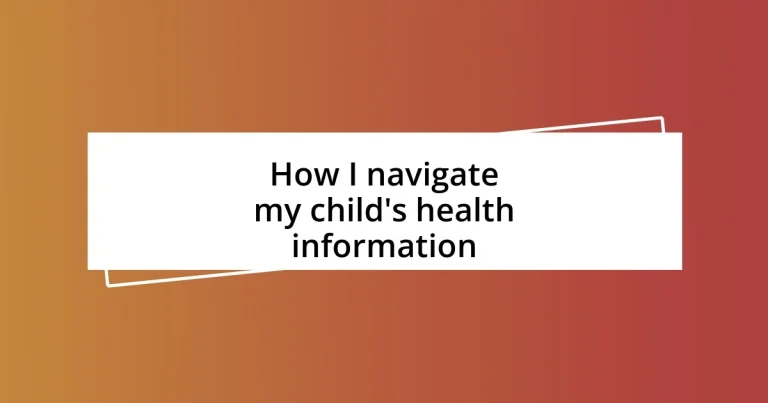Key takeaways:
- Understanding health terminology empowers parents to communicate effectively with healthcare providers and make informed decisions about their child’s health.
- Utilizing reputable sources and maintaining organized medical records enhance the ability to track health information and vaccination schedules efficiently.
- Creating a family health plan fosters involvement and communication among family members, promoting shared responsibility for health goals and well-being.

Understanding health information basics
When I first started exploring my child’s health information, I found it to be a bit overwhelming. There’s a wealth of data out there, but distinguishing between reliable sources and the noise was a challenge. Have you ever felt similarly lost while sifting through health articles online?
Understanding basic health terminology has made a significant difference for me. For instance, grasping terms like ‘symptoms,’ ‘diagnosis,’ and ‘treatment options’ transformed my conversations with pediatricians. When I could explain my concerns clearly, I noticed that the doctor’s responses were more tailored to our situation. Can you relate to that feeling of empowerment when you speak the same language as your healthcare provider?
As I navigated this information landscape, I learned to seek out reputable resources—like established medical organizations and peer-reviewed journals. It’s comforting to know that I’m relying on information that is grounded in research rather than hearsay. This conscious choice often gives me peace of mind when I’m faced with tough decisions about my child’s health. What trusted sources do you turn to during these times?
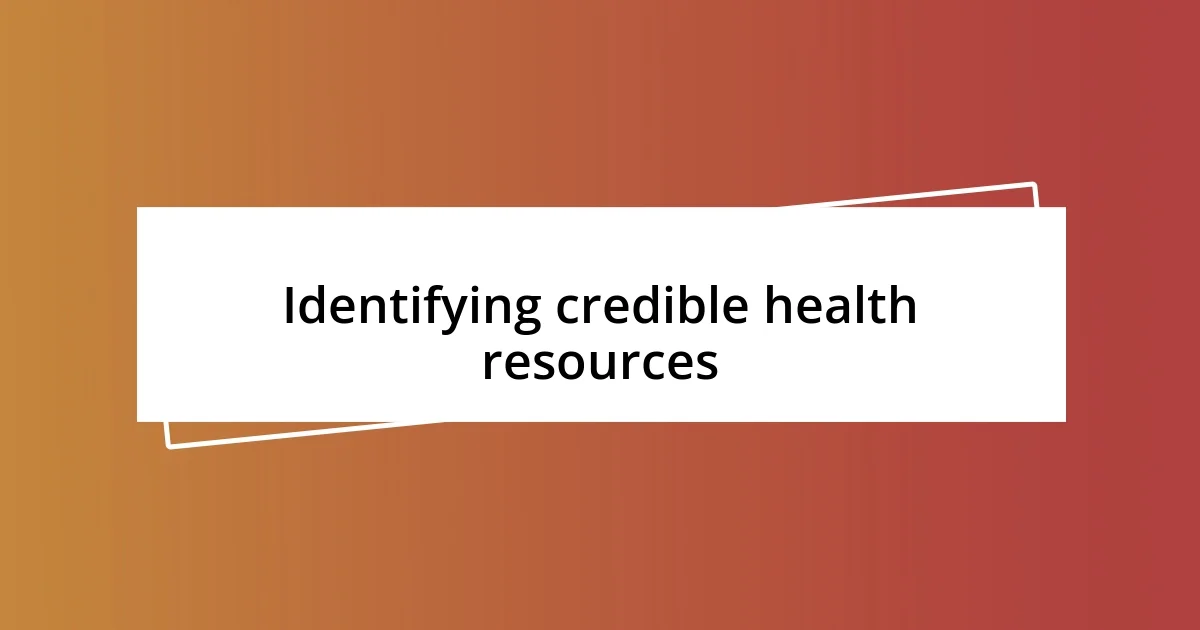
Identifying credible health resources
When I’m on the hunt for credible health resources for my child, I always keep a few key indicators in mind. Websites affiliated with respected medical organizations, like the American Academy of Pediatrics or the Mayo Clinic, are usually goldmines of reliable information. They provide evidence-backed insights that help me feel secure in the choices I make for my child’s well-being. How do you determine which websites are trustworthy?
Another factor I look for is the presence of authorship and credentials. If an article is written by a medical professional, it elevates my confidence in the information presented. There’s something reassuring about knowing the person behind the content holds expertise in their field. I often find myself making a note of the author’s qualifications, which helps me gauge the reliability of the resource. Have you ever checked an author’s background before fully trusting their insights?
Lastly, I pay attention to the date of publication. Health information can evolve over time, so I seek resources that are current and updated regularly. I vividly recall coming across an article that was five years old, which led me to question its relevance. I want the most accurate and timely information available for my child’s health needs. How often do you update your health information sources to ensure they’re still applicable?
| Indicator | Description |
|---|---|
| Affiliation | Credible organizations provide reliable information. |
| Authorship | Expertise of the author increases trustworthiness. |
| Publication date | Current information is vital for informed decisions. |
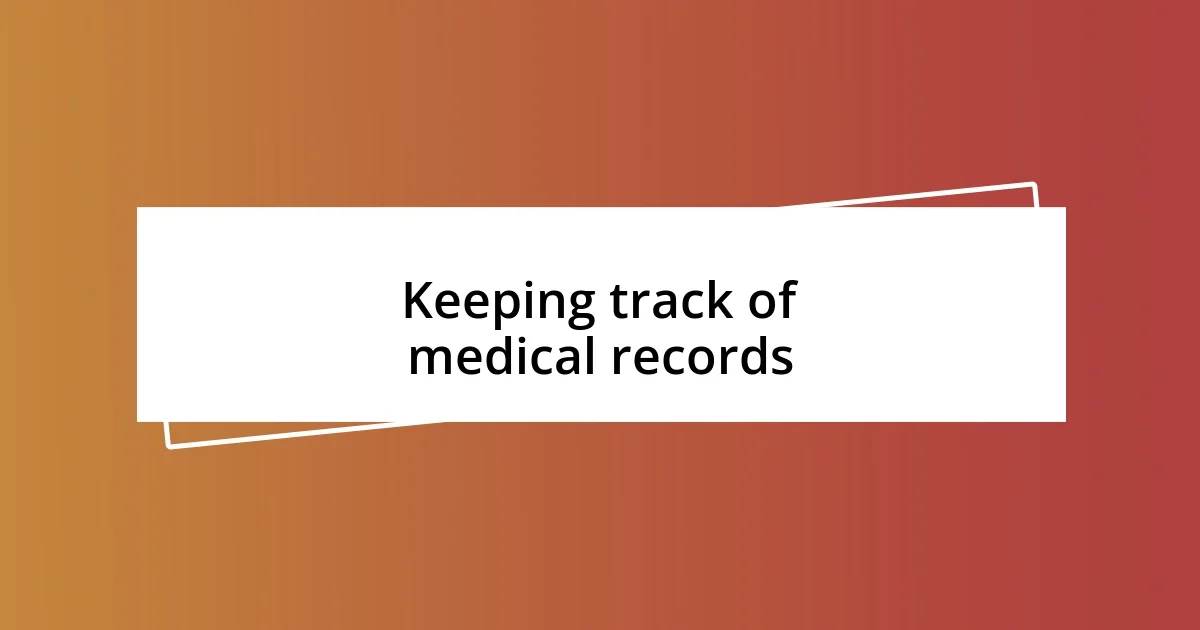
Keeping track of medical records
Keeping accurate medical records for my child has turned into a vital part of navigating their health journey. I remember the first time I had to track a series of vaccinations and follow-up appointments; it felt like a daunting task. I was overwhelmed by the number of documents and timelines. To streamline the process, I created a dedicated folder on my computer and one physically at home where I keep all their medical paperwork organized. This simple act brought me a sense of control and confidence.
Here are some strategies I’ve found to be particularly effective in managing these records:
- Create a digital and physical filing system: Keep both digital copies and hard copies of important documents.
- Use a consistent labeling method: Clearly label files by date and type (e.g., vaccinations, check-ups).
- Set reminders for follow-ups: Utilize digital calendars or apps to schedule routine check-ups and vaccinations.
- Update records after each appointment: Take a moment to ensure all notes and documents are added right after the visit.
- Share access with caregivers: If family members are involved in your child’s care, make sure they know how to access these files.
Having all the information readily available during doctor’s visits has been invaluable. I recall an instance when a pediatrician asked about my child’s medical history, and I was able to pull up the vaccination records in seconds. That moment truly underscored how crucial it is to be organized—I felt prepared and engaged in my child’s healthcare plan. Have you ever felt the relief of being on top of your child’s health records?

Communicating with healthcare providers
When I communicate with healthcare providers, I make it a point to be prepared. Before appointments, I jot down specific questions or concerns I want to address. I’ve learned that having a clear agenda not only helps me stay focused but also conveys to the provider that I am invested in my child’s health. It’s a simple tactic, but it makes a noticeable difference. Do you have a list ready before you visit the doctor?
During the appointment, I try to engage actively in the conversation. I’ve found that openly discussing my observations about my child’s health can lead to more informed suggestions from the healthcare provider. For instance, I once mentioned some unusual behavior my child was exhibiting, which opened up a dialogue about potential dietary adjustments. That moment reinforced how essential it is to foster a collaborative relationship with the provider. How often do you feel comfortable sharing your personal observations?
After our visits, I always take a moment to summarize what was discussed. I recall a time when I misunderstood a recommendation regarding medication timing, and it caused unnecessary stress until I clarified it later. By confirming my understanding and following up with any additional questions, I ensure everyone is on the same page. This practice has empowered me to be an advocate for my child’s health. Have you ever taken the time to summarize an appointment to solidify your understanding?
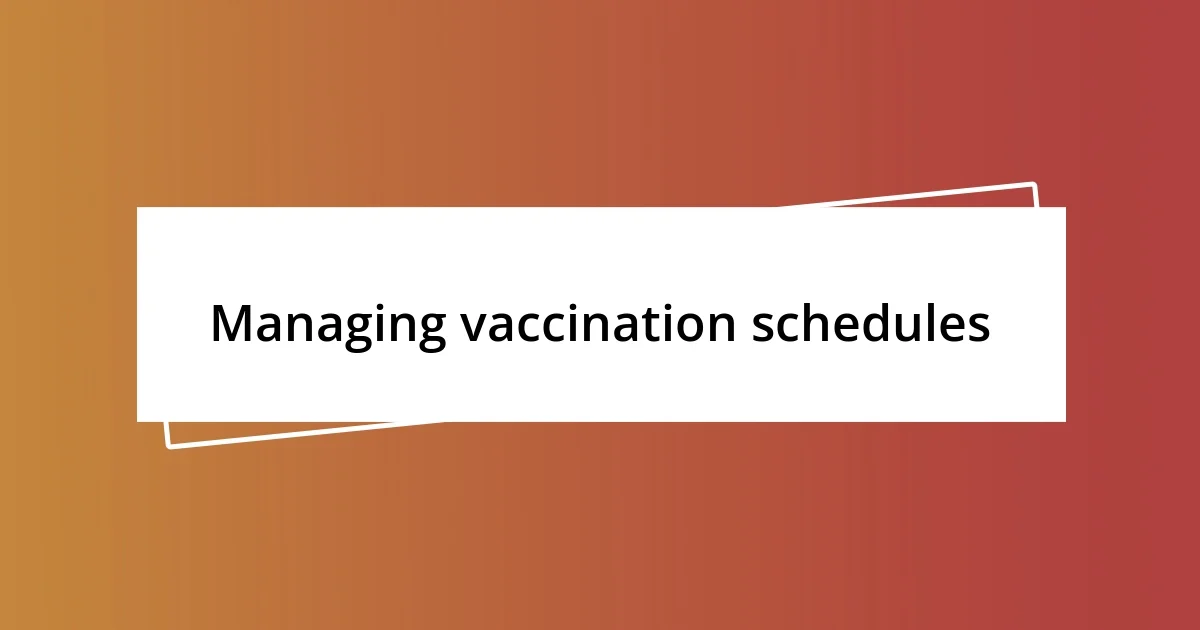
Managing vaccination schedules
Managing vaccination schedules can feel overwhelming, especially with the myriad of shots a child needs in their early years. I recall feeling a mix of anxiety and uncertainty when my first child was due for their immunizations. Keeping track of which vaccines were given and when, along with any side effects, felt like a juggling act. To simplify things, I started using a visual calendar hanging on our fridge. It not only served as a handy reminder but also provided a daily reminder of my child’s health milestones. Have you ever found a simple visual tool to make a complex task more manageable?
To ensure I didn’t miss any important dates, I set reminders on my phone that pinged me a week before each vaccination was due. This proactive approach really lessened the stress of remembering, allowing me to focus more on my child’s well-being than on worrying about missed shots. There was one moment, when I received a notification while on vacation, that I truly appreciated this system. It gave me peace of mind, knowing that my little one was set to receive their booster shots right on schedule. Do you use tech to stay on top of your child’s health appointments?
I also made it a habit to review the vaccination schedule provided by our pediatrician during each visit. Engaging with this document helped me feel more connected to the process, and I loved discussing it with my child as they got older. We would often talk about what vaccines were coming next and why they mattered, sparking their curiosity about health. This dialogue fostered a sense of involvement and empowerment in my child, and honestly, it helped ease my worries too. I wonder, have you found ways to engage your child in their health journey that have made a difference in their perspective?
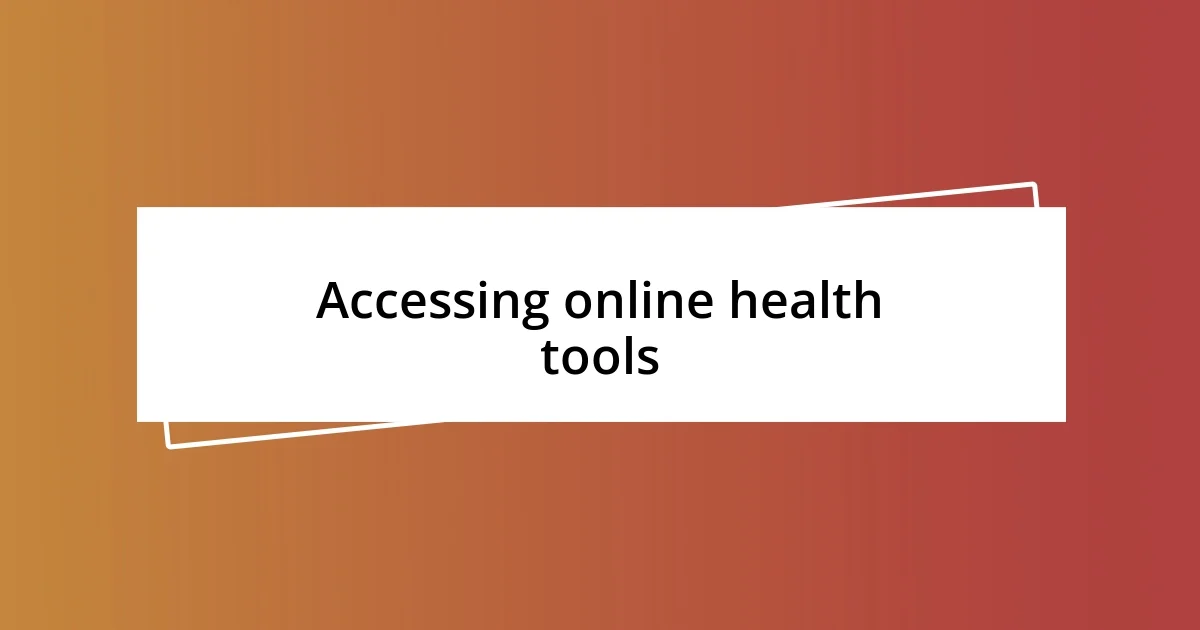
Accessing online health tools
Accessing online health tools has been a game-changer for me in navigating my child’s health information. I remember the first time I explored a telehealth service; it felt like stepping into a modern-day convenience store for health advice. I could schedule virtual appointments that fit our busy lives, which freed us up from the stress of waiting rooms. Have you tried using telehealth services for your child’s health needs?
When searching for reliable health information online, I discovered the importance of utilizing trusted websites and apps. I always look for resources recommended by healthcare professionals, as this ensures the information is credible. For example, I frequently use a parenting app that consolidates vaccination schedules and developmental milestones, which has helped me stay organized. It saves me time and gives me peace of mind knowing I’m accessing accurate data. What platforms do you turn to when you need quick health insights?
I also make it a point to engage in online health communities. One time, I joined a forum focused on childhood allergies, and the shared experiences were both reassuring and enlightening. It felt comforting to connect with other parents navigating similar situations, often leading to practical tips I hadn’t considered before. These communities have enriched my understanding and created a support network that I genuinely appreciate. Have you ever felt the power of shared experiences when exploring your child’s health concerns online?
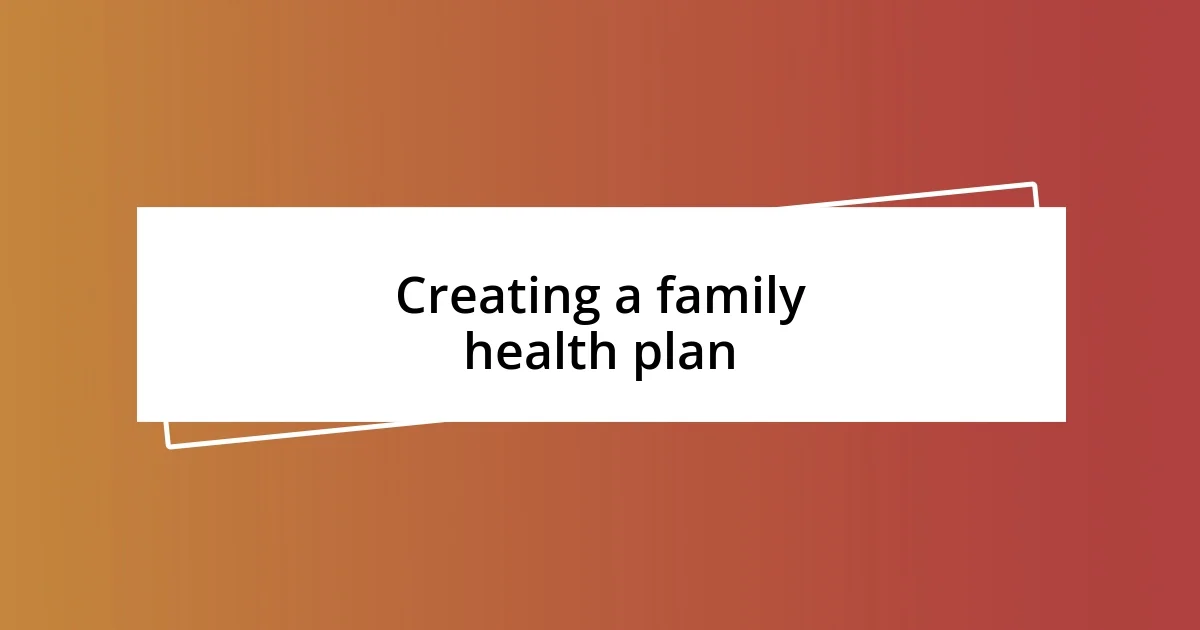
Creating a family health plan
Creating a family health plan starts with an honest assessment of everyone’s medical needs and preferences. I found it incredibly helpful to sit down with my partner and our children, discussing what health goals we had as a family. We identified what conditions, allergies, or preferences we needed to consider, which made us all feel included in the process. Have you ever involved your kids in planning their health journey?
After we mapped out our goals, I discovered how crucial it was to set specific strategies and resources for each need. For instance, we decided on a family activity schedule that included a mix of outdoor play, balanced meals, and regular check-ups. One afternoon, while preparing a healthy dinner together, we discussed the importance of nutrition. It not only brought us closer but also empowered my kids to take ownership of their health choices. Do you have family rituals that promote well-being?
Lastly, I learned that regularly reviewing and updating our family health plan keeps us on track and allows for adjustments based on changing needs. Once a month, we would gather to discuss how we felt about our health goals. I remember a time when my child shared their desire to try new sports—this prompted us to explore options that fit our active lifestyle. This flexible approach fosters open communication and dynamic support among us, ensuring we all feel heard and involved. What steps do you take to keep your family engaged in their health plans?












